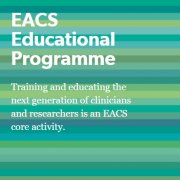Interview with EACS Vice President on World Hepatitis Day
On the occasion of the World Hepatitis Day, whose aim is drawing attention to the global burden of viral hepatitis and to take action to reduce the number of undiagnosed cases, the European AIDS Clinical Society (EACS) secretariat interviewed its Vice President, Dr Sanjay Bhagani. He is a consultant physician in Infectious Diseases/HIV Medicine and General (internal) Medicine at the Royal Free Hospital in London with a special focus in the management of HIV in-patients with complex multi-system and opportunistic infections and patients with viral hepatitis coinfections. Dr Bhagani has an active interest in teaching doctors and post-graduates from resource-poor settings about managing HIV-associated opportunistic infections and viral hepatitis co-infections.
According to ECDC data, there are around 4.7 million chronic hepatitis B virus (HBV) cases and 3.9 million chronic hepatitis C virus (HCV) cases in the EU/EEA. Moreover, the proportion of undiagnosed HBV/HCV cases in the Region is relatively high. According to you, what are the main existing barriers to the prevention and treatment of HBV/HCV?
Let’s start with HBV. The epidemiology of HBV in the region is unique. For us, this is an infection that is mostly acquired in adult life through sexual transmission and injecting drug use, unlike West and Central Africa and South East Asia where the vast majority of infections are acquired either through vertical or horizontal transmission in early childhood. HBV is entirely vaccine-preventable. Whilst HBV vaccination has been introduced in the expanded programme of childhood immunization across most of the region, vaccine schedule completion is far from ideal. We need to make a huge effort in ensuring completion of HBV vaccination schedules, and ‘catch-up’ vaccination for ‘key populations’ including men who have sex with men (MSM), people who inject drugs (PWID), sex workers and household contacts. There is also a large prevalence of HBV amongst migrants from regions of the world with high seroprevalence. This also needs to be addressed, in terms of timely testing and vaccination for sexual and household contacts.
HCV, on the other hand, is a major issue in some parts of the region in key populations including MSM, PWID and prisoners. Here, we have no vaccination but very effective treatment that is easy to administer. The key issues here are effective prevention of transmission, early identification of those with infection and early treatment.
The WHO has issued targets for HBV and HCV testing, prevention and treatment that we should all strive to achieve to eliminate chronic viral hepatitis as a threat to global health by 2030. A lot of countries are on target to achieve these goals; however, the Sars-CoV-2 pandemic will harm many of these programmes. As we come through global control of COVID-19, we mustn’t take our eye off the many gains that we have made in combating HIV, tuberculosis (TB) and viral hepatitis.
What are the key developments in the field of HBV/HCV research over the past 20 years?
Perhaps the single biggest achievement in the world of viral hepatitis is the development and advent of Directly Acting Antiviral therapies (DAAs). These are combinations of oral antiviral drugs taken for between 8-16 weeks with more than 90% success in curing hepatitis C. Many of these combinations have been donated to the Medicines Patent Pool and are now manufactured generically. Making them available to all who need them is the key challenge.
For hepatitis B, prevention with a vaccine has been a huge achievement. Also, more importantly, working through the importance of a single birth-dose vaccine to prevent vertical transmission and the use of oral antiviral therapies for treatment are tremendous gains. More recent research efforts for HBV are now focusing on the concept of a ‘functional’ or ‘sterilising’ cure for those with chronic HBV infection.
Are people living with HIV (PLWH) at a higher risk of contracting HBV/HCV? Why?
Because of their shared routes of transmission, it is not surprising that co-infections with HIV and HBV or HCV are common. Over the last 15-20 years, we have seen an epidemic of HCV infections in HIV-infected men who have sex with men. Whilst this is multi-factorial, the key risk factors seem to be sex under the influence of recreational drugs, traumatic sex, multiple partners and group sex, as well as the presence of sexually transmitted infections. In this group, ‘treatment of HCV as prevention’ has been a key achievement. Groups from the Netherlands, Switzerland and the UK have all demonstrated that widespread use of early DAAs will have a positive impact on this epidemic. Partners from the NEAT ID Foundation, EACS and EASL have recently developed updated consensus guidelines for the management of recently acquired HCV.
How does HIV infection interact with HBV/HCV virus?
One of the key interactions between HIV and HCV and HBV is the negative impact of HIV on the immune system. This makes individuals infected with HIV more susceptible to developing chronic infection once exposed to HBV or HCV, and then develop faster progressive liver inflammation and fibrosis. The key, therefore, is to have strategies to prevent infection with HBV and HCV in HIV-positive patients by appropriate vaccination and lifestyle modification advice. For active injecting drug use, a well-developed needle and syringe exchange programme are also essential. Once chronic HBV or HCV infection is identified, early dual-active ART for HBV and early DAAs for HCV are crucial.
What are the effects of delayed treatment of HBV/HCV in PLWH?
As mentioned above, the risk of progression to cirrhosis and complications of end-stage liver disease are greater in individuals co-infected with HIV. Early viral hepatitis-directed treatment and lifestyle changes, including moderating alcohol use, are essential for this group of patients.
What is the link between drug injection and HBV/HCV?
Injecting drug-use is the single biggest contributor to world-wide cases of HCV infection. This is in a large part linked to the sharing of injecting paraphernalia, facilitating transmission of HCV between individuals. For this group of individuals, injection safety (sterile needles and syringes, discouraging sharing), opiate-agonist therapy programmes to facilitate non-injection, and early identification of HCV infection and treatment are key areas of attention. The positive impact of these programmes have been demonstrated in many parts of the world. Injecting and psychoactive drug use is a global problem with multi-dimensional problems and needs all of us to work together to address this.

20th European AIDS Conference
15-18 October 2025 Paris, France

EACS Guidelines updated
The EACS 12.0 and the app are available for free on

Educational Programme
Training and educating the next generation of clinicians and researchers is an EACS core activity.

EACS Resource Library
Access all scientific content of EACS core activities! (members only)
